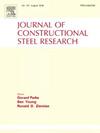Research on axial compression performance of recycled aggregate concrete-filled steel tubular column
IF 4
2区 工程技术
Q1 CONSTRUCTION & BUILDING TECHNOLOGY
引用次数: 0
Abstract
This research investigated the axial compression performance of recycled aggregate concrete-filled circular steel tubular columns (CRACFST). The axial compression test was conducted with 20 test specimens of CRACFST. The effects of core concrete strength, aggregate particle size and recycled aggregate replacement rate on axial compression performance of the test specimen were studied in this research. This investigation analyzed the failure mode, ultimate axial compression bearing capacity, compression toughness, initial stiffness and ductility of CRACFST under axial compression tests. The ultimate axial compression bearing capacity was increased with the increase of core concrete strength and decreased with the increase of recycled aggregate replacement rate. In addition, the ultimate axial compression bearing capacity of CRACFST test specimen under axial compression was a little decreased with aggregate particle size increased. According to axial compression test results, nominal compression strength of core concrete of 30 MPa and a recycled aggregate replacement rate of not over 50 % were suggested for CRACFST. The results indicated that it is feasible to replace ordinary aggregate concrete with recycled aggregate concrete. Additionally, the numerical simulation method was used to analyze axial compression behavior of CRACFST specimen. The effects of steel tube thickness and column height on axial behavior of CRACFST were conducted according to the numerical mode. According to test and numerical simulation results, a calculation formula for ultimate axial compression bearing capacity of CRACFST was provided in this investigation. A good agreement with the test and numerical simulation results was achieved.
求助全文
约1分钟内获得全文
求助全文
来源期刊

Journal of Constructional Steel Research
工程技术-工程:土木
CiteScore
7.90
自引率
19.50%
发文量
550
审稿时长
46 days
期刊介绍:
The Journal of Constructional Steel Research provides an international forum for the presentation and discussion of the latest developments in structural steel research and their applications. It is aimed not only at researchers but also at those likely to be most affected by research results, i.e. designers and fabricators. Original papers of a high standard dealing with all aspects of steel research including theoretical and experimental research on elements, assemblages, connection and material properties are considered for publication.
 求助内容:
求助内容: 应助结果提醒方式:
应助结果提醒方式:


